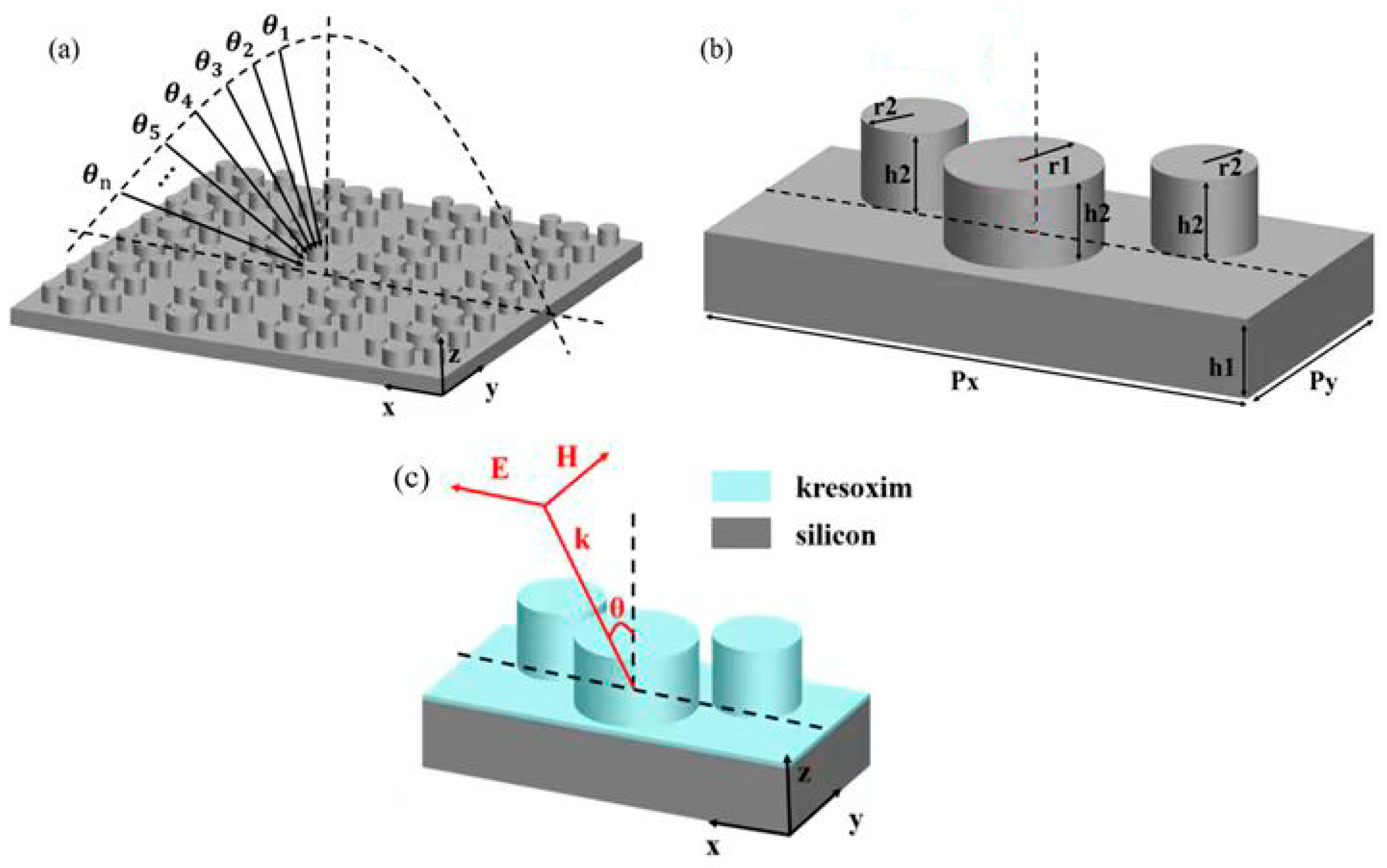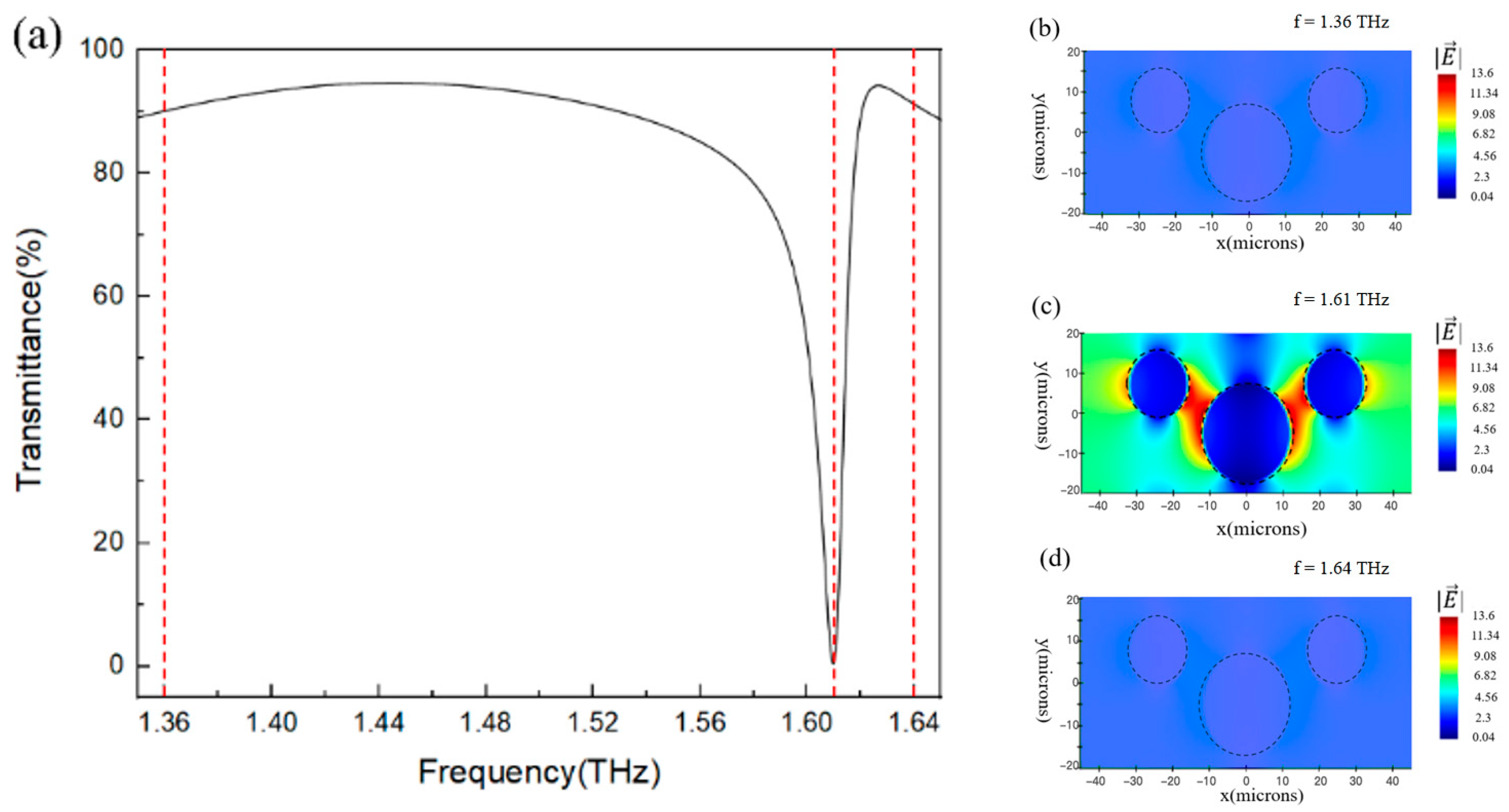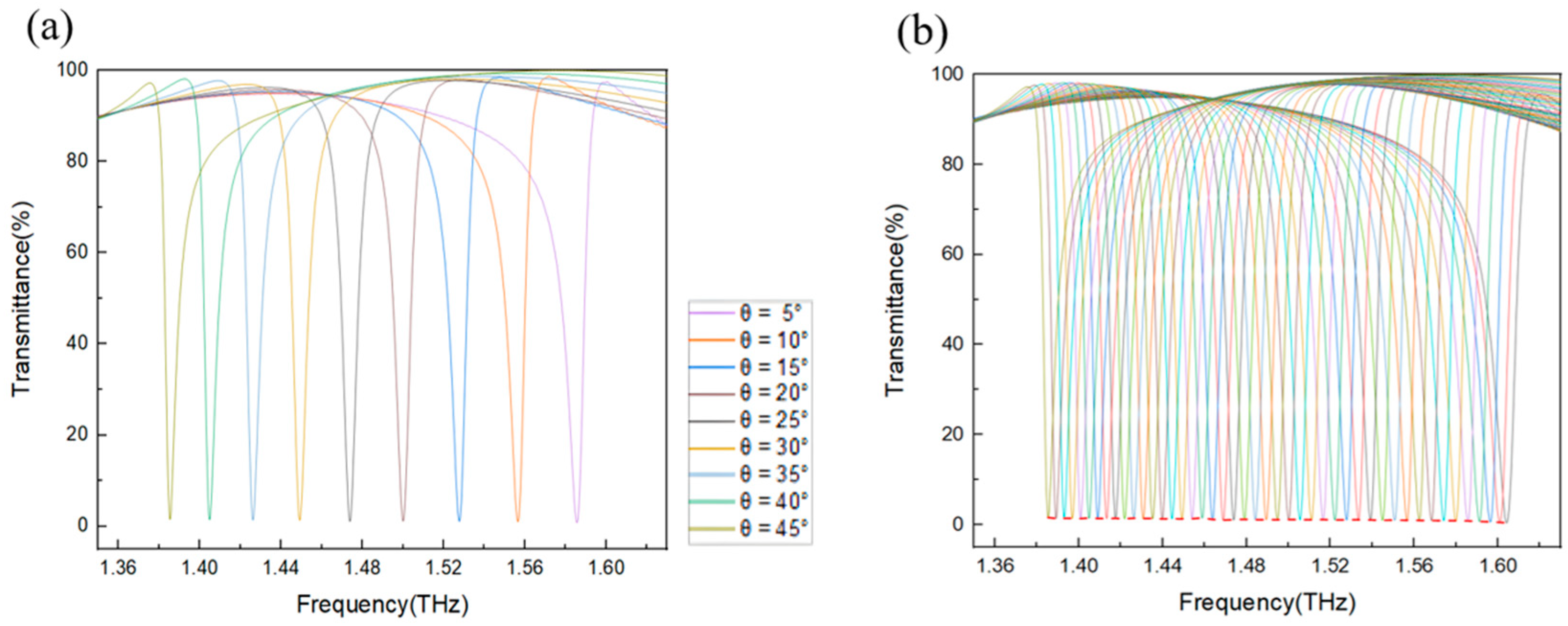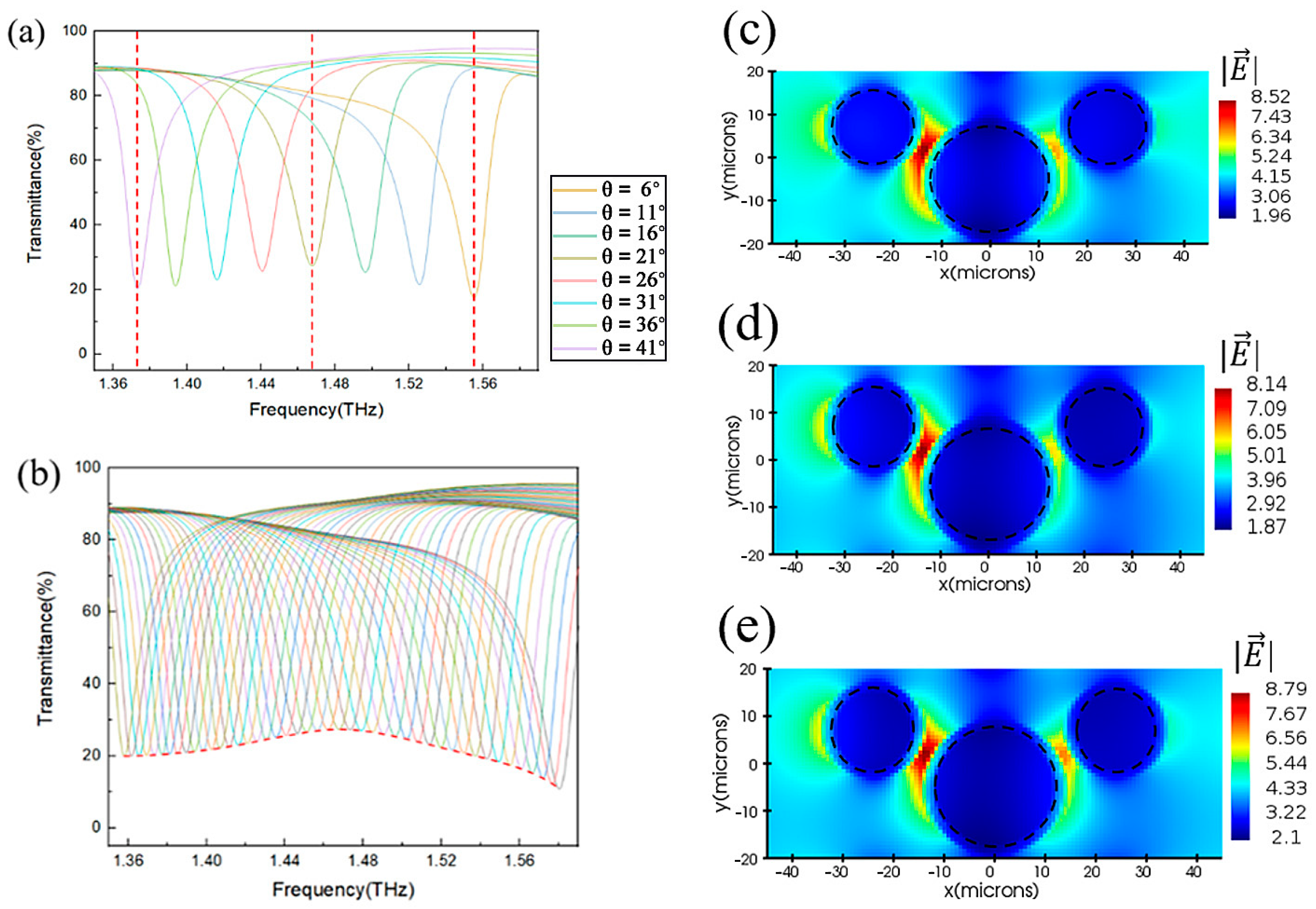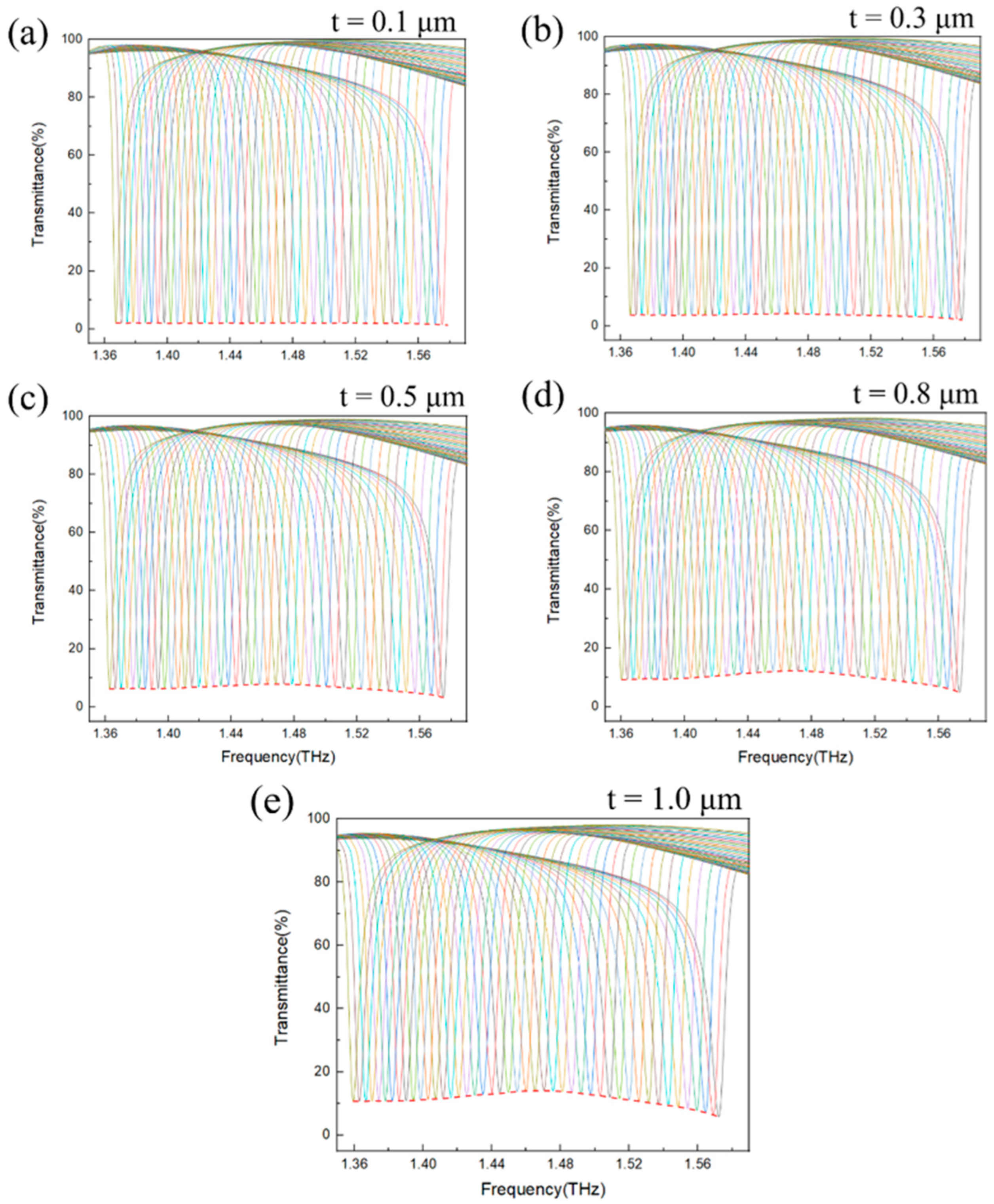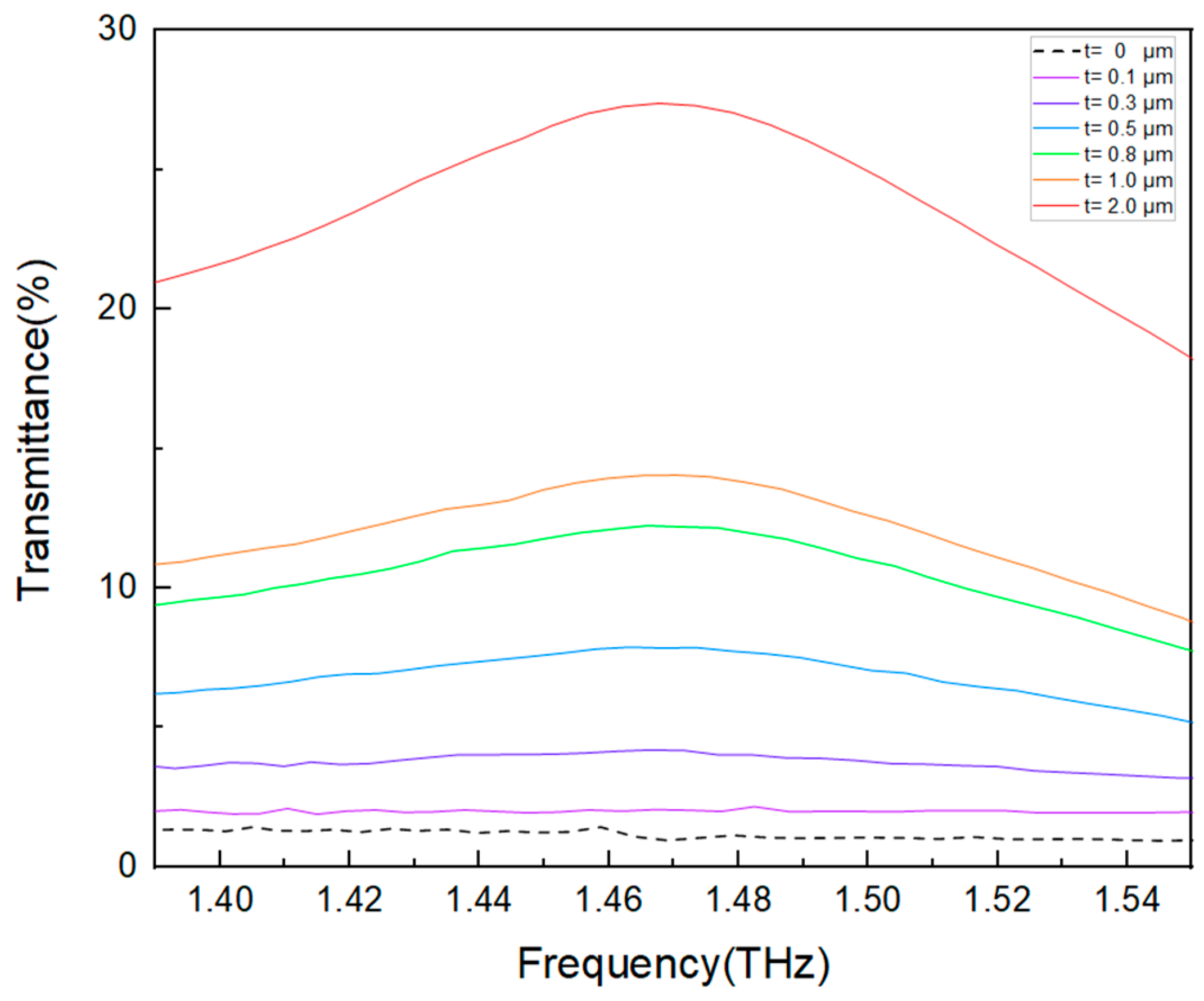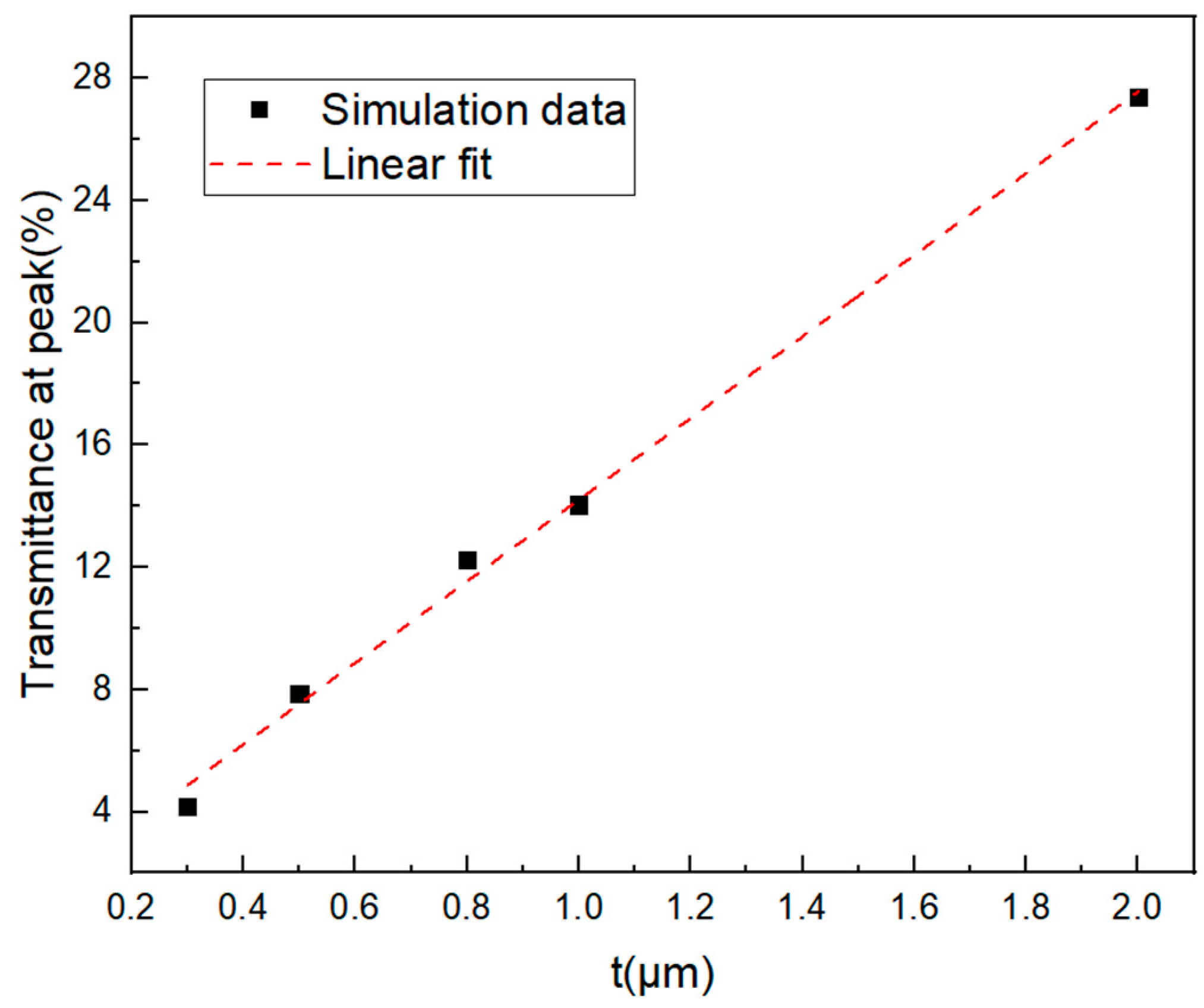1. Introduction
The electromagnetic spectrum of terahertz (THz) waves spans the frequency range of from 0.1 to 10 THz [
1]. It not only demonstrates the properties of microwave and infrared waves but also possesses numerous exceptional advantages. For instance, THz waves exhibit transparency to the majority of dielectric materials [
2], facilitate non-destructive inspection, and possess a high signal-to-noise ratio. THz technology demonstrates significant potential in biomedical research, because the label-free characteristic of THz waves facilitates a more reliable and reproducible detection of biological tissues. THz fingerprint sensing technology relies on the distinct “spectral fingerprint” characteristic of THz waves, enabling the acquisition of transmission, absorption, or reflection spectra of samples. The distinctive peaks encompass the specific material information of the sample and can precisely determine its composition. In practical applications, when the sample content is minimal, the detection capability of the THz-TDS system is significantly limited [
3]. The considerable disparity between the wavelength of THz waves and the sample thickness further constrains the efficacy of conventional detection methods in trace analysis [
4].
Metamaterials are periodic artificial structures composed of metal–dielectric–metal or entirely dielectric layers with subwavelength dimensions. Metamaterial sensors are optimal for surface-enhanced infrared absorption spectroscopy applications because of their minimal radiation damping in the infrared spectrum [
5,
6] and their high absorption capability. Optimal absorption of these materials can be attained across various frequency ranges, from visible light to microwaves, by selecting diverse geometries of varying dimensions. THz sensors engineered for infrared wavelengths can identify extremely faint signals linked to the vibrational modes of relevant molecules. Recent research on metamaterial structures has focused on improving the signal of these molecules [
7,
8]. Moreover, the distinctive features of multimode antennas create new opportunities for various potential applications, including pyroelectric detectors, solar energy harvesting, sensors, and optical filters. Landy et al. exhibited the inaugural sensor, utilizing a metallic aperture ring and a cutting wire, achieving an absorbance of 88% [
9]. Currently, metamaterial sensors are extensively employed to detect the molecular fingerprints of chemical and biological substances in the THz region. Throughout the past decade, numerous metamaterials have been created, including all-dielectric metamaterials [
9], tunable metamaterials [
10,
11,
12], metasurfaces, reconfigurable metamaterials [
13,
14], flexible metamaterials [
15], and graphene metamaterials. Specifically, integrating THz spectroscopy techniques with metamaterials will enhance signal amplification and increase detection sensitivity.
In recent years, numerous researchers have concentrated on developing metamaterial structures appropriate for THz fingerprint sensing. In 2020, Pengcheng Nie and associates devised a highly sensitive detection technique utilizing a broadband terahertz dielectric metamaterial absorber for the trace detection of the pesticide chlorpyrifos. The sensor exhibited a minimum detection concentration of 0.1 mg/L [
16], demonstrating commendable stability and reproducibility. This method employs the linear responses of the absorption peak intensity and frequency shift, offering an innovative solution for swift and accurate detection in food safety. In 2021, Khwanchai Tantiwanichapan and colleagues developed a detection system utilizing a terahertz metamaterial absorber for the high-sensitivity detection of prevalent pesticide residues, including paraquat and glyphosate [
17]. The detection system can accurately measure pesticide concentrations by red-shifting the absorption frequency. In a recent three-year study, Meng et al. reported, in 2022, that an all-dielectric metamaterial, in conjunction with angle scanning technology [
18], systematically elucidated its physical mechanism for enhanced detection by applying analytes to its surface, and they validated its superior sensing capabilities for substances like tyrosine. In 2023, Zhang et al. introduced a THz metamaterial sensor exhibiting near-perfect absorption through superreflection, discovering a robust linear correlation between the shift in formant frequency and ascorbic acid concentration [
19]. In that year, Lang et al. advanced a highly sensitive flexible THz metamaterial for detecting the pesticide imidacloprid, achieving a detection sensitivity of 12.3 GHz/(mg/mL) and a detection limit of 0.0112 mg/mL [
20]. These studies demonstrate that metamaterials are essential to THz fingerprint sensing technology and are a significant catalyst for technological advancement in this domain. As research on THz metamaterials advances, we anticipate that the application of THz fingerprint sensing technology in areas such as pesticide residue detection will become increasingly widespread and comprehensive.
The local field enhancement effect of metal-containing metamaterials arises from the excitation and modulation of surface plasmons. By constraining the electromagnetic energy at the metal–dielectric interface, the intensity of the electromagnetic field is amplified and becomes responsive to variations in the dielectric environment at the interface, which is extensively utilized in electromagnetic wave modulation and sensing applications. All-dielectric metamaterials enhance fields via mechanisms including optical resonance, photonic crystal effects, and Mie resonance. They possess advantages such as a high refractive index and low loss, demonstrating a robust optical response at specific frequencies due to meticulously designed geometric structures, indicating significant potential in THz fingerprint sensing technology.
The swift advancement of contemporary agriculture is leading to a gradual increase in both the variety and quantity of pesticides. The increasing prevalence of pesticide poisoning in recent years has garnered sustained attention. Kresoxim-methyl [
21], a highly efficient fungicide pesticide with a broad spectrum and prolonged efficacy, is esteemed by farmers in agricultural production due to its substantial effectiveness in controlling various diseases. Nonetheless, it is important to acknowledge that the degradation rate of kresoxim-methyl in soil is comparatively slow, resulting in its accumulation in soil and crops, thereby presenting a potential environmental pollution risk. Prolonged exposure to or inhalation of ether ester may lead to various health issues, including dizziness, nausea, vomiting, and potentially life-threatening symptoms. Conventional pesticide residue detection methods exhibit limitations, including inadequate sensitivity and selectivity, laborious and intricate procedures, costly equipment, elevated expenses, inability for real-time detection, and suboptimal detection relevance, alongside inherent environmental and health risks. These challenges hinder the fulfillment of contemporary agricultural demands for rapid, economical, portable, and comprehensive testing.
Given the extensive application and potential risks associated with kresoxim-methyl, this study focuses on kresoxim-methyl as the primary detection target and employs the Finite-Difference Time-Domain (FDTD) Solutions tool to design an all-silicon trimeric cylindrical THz metamaterial fingerprint sensor. The sensor exhibited a pronounced resonance dip at 1.61 THz with a Q factor of approximately 143. The metamaterial enhances the electric field and localizes it to the surface, thereby amplifying the interaction of THz waves with the analyte. Through angle scanning, the sensor was utilized to detect the pesticide ether ester. The resonance concave envelope derived from angle scanning displayed a peak at 1.47 THz, corresponding to the THz fingerprint information at this frequency, facilitating the identification of kresoxim-methyl. A strong linear correlation existed between the peak value of the envelope and the thickness of the ether ester, enabling the quantification of the ether ester concentration. The proposed sensor is capable of detecting additional pesticides with fingerprint peaks within the 1.36–1.64 THz band. The sensor is reusable. The sample maintain its stability during the testing procedure.
3. Results and Discussion
Resonances in the guided mode, governed by bound states in the continuum (BIC), can be stimulated by precisely arranging the geometric configuration of the SCT [
23] within the sensor. The BIC arises from the asymmetrical discrepancy between the mode distribution of light waves and the external propagation mode under specific conditions, resulting in the confinement of light waves within the medium and preventing their radiation, thereby amplifying the interaction between light and matter. Despite the theoretical possibility of a BIC possessing an infinite Q value, attaining this ideal condition in practice proves challenging. Consequently, a BIC [
24] can be converted into a quasi-BIC by disrupting the symmetry of the silicon column trimer, which can be stimulated by the incident wave while preserving its high Q factor characteristics. The Q factor of a quasi-BIC is intricately linked to the extent of breaking the in-plane inversion symmetry of the hypersurface structure. The Q factor can be altered by modifying the degree of asymmetry of the metasurface unit cells. The establishment of a quasi-BIC markedly improves the guided-mode resonance [
25], evident as a pronounced transmission dip in the spectrum, thereby offering substantial spectral feature support for the targeted detection of ether ester molecules.
Upon vertical incidence of the THz wave on the SCT metamaterial surface, the resultant transmission spectrum and electromagnetic field distribution at the formant are illustrated in
Figure 2.
Figure 2a reveals a notable resonance depression at 1.61 THz, characterized by a full width at half maximum (FWHM) of approximately 0.01 THz. The Q value (quality factor) of this resonance depression was estimated to be approximately 143 [
26]. The resonance sag phenomenon is a result of the excitation of guided mode resonance. In SCT metamaterial structures, the silicon substrate functions as the waveguide layer, whereas the silicon column trimer serves as a two-dimensional grating. The incident THz wave couples to the waveguide mode through diffraction, successfully exciting the guided mode resonance [
27].
Additionally,
Figure 2b, c, and d illustrate the electric field distribution on the surface of the SCT metamaterial at frequencies of 1.36 THz, 1.61 THz, and 1.64 THz, respectively. The electric field intensity at 1.61 THz was markedly greater than at 1.36 THz and 1.64 THz, signifying that the electric field gain attained its peak at a resonance frequency of 1.61 THz. At this frequency [
28], the electric field intensity was predominantly focused in the area between the larger silicon column and the smaller silicon column on either side, indicating a significant local electric field enhancement effect at the resonance point.
Notably, a thorough analysis of the data in
Figure 3a revealed a strong linear correlation between the frequency shift of the resonance depression and the angle of incidence θ. This discovery elucidates the quantitative correlation between the spectral response and the incident angle of the SCT metamaterial [
29], which is crucial for optimizing metamaterial design and achieving precise spectral regulation.
The angular-dependent spectral response can be elucidated by guided-mode resonance theory [
30]. When an incident wave traverses a metamaterial at a specific angle θ, it induces waveguide patterns at the corresponding frequency. This mode enables the effective capture and propagation of the incident wave within the metamaterial, thereby facilitating the regulation of light waves. The phase matching condition between the in-plane component of the incident light vector and the waveguide’s mode propagation constant can be established according to grating diffraction theory. The mathematical expression for the guided-mode resonance condition can be derived by integrating the guided-mode propagation condition with the waveguide boundary condition, resulting in the law governing the guided-mode resonance as a function of the incident angle.
Figure 3b provides a detailed representation of the angular variation in the SCT metamaterial transmission spectra as the incident angle θ increased from 1° to 45° in increments of 1°. The red dashed line in
Figure 3b shows the resonance depression of the transmission spectrum at different incidence angles. To make the analysis easier, these data are plotted as an envelope curve. The potential use of SCT metamaterials in analyte THz fingerprint sensing is demonstrated by this envelope curve, which spans a wide THz frequency band. Covering the surface of the SCT metamaterial with an analyte’s characteristic peak in this frequency band causes the envelope curve to reflect the analyte’s extinction coefficient curve, allowing for the specific detection of the substance.
Initial steps involved scanning a 2.0 μm thick kresoxim-methyl film from an angle ranging from 1° to 45°.
Figure 4 displays the resulting images. The resonance frequency dropped into a lower frequency band as the incidence angle increased, as seen by the transmission curve’s noticeable red-shift. The transmittance at the resonance depression initially increased, subsequently decreased, and reached a maximum at θ = 21°. At present, the resonance depression frequency is approximately 1.47 THz, which is in agreement with the kresoxim-methyl extinction coefficient curve.
The distribution of the surface electric field of the metamaterial at the frequency of the resonance depression at θ = 6°, θ = 21°, and θ = 41° is shown in
Figure 4c, d, and e, respectively. The uneven distribution of electric fields across the metamaterial’s surface is a result of the angle at which the light wave is incident. More specifically, the area between the leftmost larger and smaller silicon columns is where the strongest electric field is concentrated. When θ = 21°, the electric field gain reached its maximum, which is highly correlated with kresoxim-methyl’s properties and offers a solid spectral characteristic foundation for future detection, further demonstrating the resonance effect’s significance through the enhancement of this localized electric field.
The extent of THz wave absorption by the analyte can be defined by the following formula [
31]:
In the aforementioned formula, V denotes the volume of the analyte, E signifies the electric field strength, and n and k represent the real and imaginary components of the complex refractive index of the analyte, respectively. The amplitude of A(f) is primarily influenced by the electric field E. The gain electric field is primarily concentrated between the larger silicon column and the smaller silicon column on the left. The silicon column enveloping the analyte allows the SCT metamaterial to markedly augment the absorption of THz waves by the analyte, thereby facilitating the detection of its THz fingerprint.
Figure 4c–e illustrate that while the electric field intensity fluctuated with varying incident angles, the peak electric field intensity at θ = 21° was inferior to that at θ = 6° and θ = 41°. When θ = 21°, the transmittance at the resonance depression was notably high, aligning with the trend of the extinction coefficient curve of kresoxim-methyl. This suggests that the local electric field enhancement of the SCT metamaterial is significantly influenced by the incidence angle of THz waves, allowing for the effective identification of the THz fingerprint information of the analytes through angle scanning.
The resemblance between the envelope of the transmission depression in
Figure 4b and the extinction coefficient curve of the analyte arises from the physical mechanism through which THz waves engage with matter. The extinction coefficient is a crucial physical parameter that characterizes a substance’s capacity to absorb electromagnetic radiation. In THz spectral analysis, the extinction coefficient is intimately associated with the molecular structure, vibrational modes, and electronic transition properties of a substance. As a THz wave traverses a sample containing a specific analyte, it interacts with the sample molecules, leading to the absorption of particular wavelengths of light and a corresponding reduction in the transmission spectrum.
To assess the sensing performance of the SCT metamaterial with varying thicknesses of kresoxim-methyl films, films measuring 0.1 μm, 0.3 μm, 0.5 μm, 0.8 μm, and 1.0 μm were systematically scanned from 1° to 45° in 1° increments. Subsequently, the resonance sag phenomena at various angles were consolidated and represented as envelope lines, as illustrated in
Figure 5. It is noteworthy that when the thickness of the kresoxim-methyl film was 0.1 μm, the envelope exhibited negligible change, suggesting that the film thickness was insufficient for the SCT metamaterials to effectively discern its THz fingerprint. As the film thickness increased to 0.3 μm, the envelope exhibited minor fluctuations, signifying that the SCT metamaterial commenced detecting the fingerprint signal of the SCT.
To facilitate clearer observation and analysis, the six envelope lines in
Figure 4b and
Figure 5 were individually extracted and redrawn, with the envelope lines devoid of analyte serving as a reference.
Figure 6 illustrates that as the film thickness increased, the envelope’s fluctuation intensified, resulting in an overall upward trend. It is particularly significant that when the film thickness attained or surpasses 0.3 μm, five envelope lines exhibited pronounced maximum values of approximately 1.47 THz, which aligns closely with the extinction coefficient curve of kresoxim-methyl.
The angle scanning results of the various thin film thicknesses effectively validated the application potential of the SCT metamaterials in THz fingerprint sensing and demonstrated a strong correlation between the thin film thickness and sensing performance. These findings offer significant experimental foundations and theoretical backing for the further optimization of metamaterial design and the enhancement of the sensing performance. The correspondence between the envelope created by the transmission sag and the extinction coefficient curve of the analyte offers an efficient analytical method. By juxtaposing the envelope with the extinction coefficient curve of established substances, the analyte can be discerned, indicating significant potential in pesticide residue detection.
The limit of detection (LOD) is a critical metric for evaluating the efficacy of metamaterial sensors. Establishing the LOD can assist in addressing the issue of uneven sample distribution. This indicator signifies that the sensor can detect pesticides as long as the local pesticide concentration surpasses the detection threshold. The LOD is defined by the following formula:
In the equation, ρ denotes the density of the observed object, while h signifies the minimum detectable thickness. The analysis of angle scanning results for various thicknesses of powder rust indicates that the minimum detectable thickness of SCT metamaterials for powder rust is 0.3 μm. At a temperature of 20 °C, the density of kresoxim-methyl is 1.258 kg/L, and the detection limit of the SCT metamaterial is 37.74 μg/cm
2, as determined by the aforementioned formula. The results demonstrate that the SCT metamaterial developed in this chapter exhibits exceptional specificity and sensitivity in the trace detection of kresoxim-methyl. To enhance the investigation of the detection efficacy of SCT metamaterial for kresoxim-methyl concentrations, we extracted peak data from the envelope lines of five thicknesses (t = 0.3 μm, 0.5 μm, 0.8 μm, 1.0 μm, and 2.0 μm) near 1.47 THz and illustrated the correlation between the peak value of the envelope and the thickness of kresoxim-methyl.
Figure 7 illustrates a significant linear correlation between the peak value of the envelope and the thickness of kresoxim-methyl. The fitted linear equation is as follows [
32]:
with a correlation coefficient of 0.99823. This discovery offers a technique to inversely extrapolate the kresoxim-methyl content by analyzing the peak value of the envelope at an angle, thereby facilitating the sensitive detection of kresoxim-methyl.
